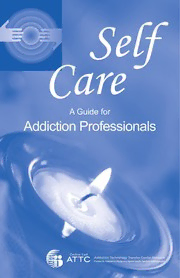
Self-Care: A Guide for Addiction Professionals PDF
Preview Self-Care: A Guide for Addiction Professionals
Self Care A Guide for Addiction Professionals Self Care A Guide for Addiction Professionals This document was prepared by The Central East Addiction Technology Transfer Center through a cooperative agreement from the Substance Abuse and Mental Health Services Administration’s (SAMHSA) Center for Substance Abuse Treatment (CSAT). The Central East ATTC is a program of the Danya Institute. The contents of this publication are solely the responsibility of the authors and do not necessarily reflect the official views of the U.S. Department of Health and Human Services (DHHS), SAMHSA or CSAT. Program Director Loss and Grief Section Author Ryan Springer, MPH Glenda Clare, PhD Editor Originally Published July 2007. Aaron M. Williams, MA Revised October 2011. Writers Paula Jones Aaron M. Williams, MA About This Guide The Central East Addiction Technology Transfer Center developed Self Care: A Guide for Addiction Professionals in 2007. The goal was to identify common workplace stressors for addiction professionals and provide strategies for both agencies and addiction professionals that can be used to address these stressors and promote overall self-care. To that end, the guide addressed such topics as nutrition, mental wellness, recovery management, and exercise. It also provided helpful tools and resources to help addiction professionals identify and reduce stress. Feedback suggests that the guide has been well-received and useful. Second, stakeholder feedback suggested that addiction professionals experience issues related to loss and grief in the course of their professional activities. Accordingly, the guide has been updated to describe the four types of loss and issues related to professional grief, such as characteristics of professional grief, major tasks of grief, signs of imbalance, and tips for maintaining balance. It describes facts about grief, common immediate reactions to grief, and common reactions after the shock. Acknowledgments The Central East Addiction Technology Transfer Center acknowledges the guidance and leadership of the original Advisory Committee, listed below. Likewise, we provide a special thanks to Mary (Betsy) McCaul, PhD, for her support and guidance during the development of this document. Advisory Committee Participating Staff Bonita M. Bantom, LICSW Kathleen Madigan Hauck, CGMP R e gin al H. Brown Frances Loranzi, MA DIIavid L. Whiters, LMSW, NCAC J acqueline Coleman, MEd L aShaun M. Evans, MHS Shirley Beckett Mikell, NCAC II Valerie E. Robinson MS, PCC Basha Silverman Carmi Washington-Flood Aaron Williams, MA (Chair) Walter Williams Table of Contents Preface ..............................................................................................3 Purpose of the Self-Care Guide ........................................................4 Section 1: Challenges in the Workplace ...........................................5 Section 2: Agency Role in Supporting Well Being ........................10 Section 3: Self-Care Approaches ....................................................17 Nutrition ...........................................................................17 Exercise/Health Promotion ..............................................21 Mental Wellness ...............................................................23 Recovery Management .....................................................29 Section 4: Loss and Grief ..............................................................31 References ......................................................................................35 Cura te ipsum ❦ (Take care of your own self) 3 Preface As the Central East Addiction enviroments. An advisory panel of Technology Transfer Center (Central experts in addiction-related services East) has worked with addiction was convened to provide input on professionals over the years, the the content and format of the guide. need for a self-care guide has been a The advisory panel provided input frequent topic of discussion. There on specific topic areas and made has been significant demand for a recommendations on the steps both guide that can be used by agencies to agencies and employees create a more supportive work can take to promote self-care and a environment for employees and by healthy work environment. This the employees themselves, to guide is based on the discussions enhance their own well-being and conducted by the advisory panel and lead healthier, more productive includes many of the specific professional and personal lives. suggestions made during those discussions. In response to this demand, the Central East set out in fall 2006 to develop a self-care guide to meet the needs of both agencies and employ- ees. To ensure that this self-care guide addresses the needs of our target audience, the Central East utilized a process designed to gain input from individuals with significant experience in working with addiction professionals and promoting healthier work 4 Purpose of the Self-Care Guide The goal of this guide is to identify It is also important to emphasize workplace stressors for addiction that there may be some situations in professionals and provide strategies the workplace, such as funding cuts, for both agencies and addiction new regulations, or increased professionals that can be used to demand for services, over which address these stressors and promote agencies and employees have little self-care. Both agencies and or no control. While little can be employees have a role to play in this done to address these situations, process. While agencies can take some of the strategies suggested in steps to reduce workplace stress and the guide will help employees better provide opportunities to enhance the adapt to emerging situations and health and well-being of their minimize the negative impact on employees, it is ultimately the their professional performance and responsibility of employees to take personal life. the steps necessary to adopt a healthier lifestyle and engage in activities that promote well being. It is important to note that the suggestions in this guide are just that, suggestions. Every agency and individual has different needs and resources. No single approach is right for all agencies and individu- als. Many of the suggested approaches are highly adaptable, allowing agencies and employees to select those aspects of an approach that best meet their needs.
